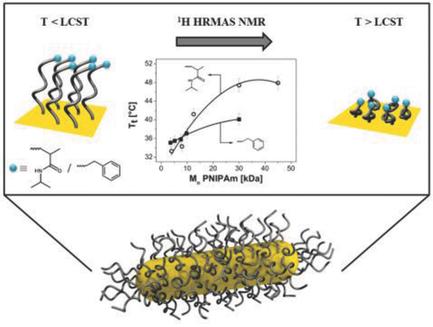当前位置:
X-MOL 学术
›
Macromol. Rapid Commun.
›
论文详情
Our official English website, www.x-mol.net, welcomes your feedback! (Note: you will need to create a separate account there.)
Thermodynamic Parameters of Temperature‐Induced Phase Transition for Brushes onto Nanoparticles: Hydrophilic versus Hydrophobic End‐Groups Functionalization
Macromolecular Rapid Communications ( IF 4.6 ) Pub Date : 2017-08-21 , DOI: 10.1002/marc.201700362 Sjören Schweizerhof 1 , Dan Eugen Demco 1, 2 , Ahmed Mourran 1 , Helmut Keul 1 , Radu Fechete 2 , Martin Möller 1, 3
Macromolecular Rapid Communications ( IF 4.6 ) Pub Date : 2017-08-21 , DOI: 10.1002/marc.201700362 Sjören Schweizerhof 1 , Dan Eugen Demco 1, 2 , Ahmed Mourran 1 , Helmut Keul 1 , Radu Fechete 2 , Martin Möller 1, 3
Affiliation

|
Quantification of the stimuli‐responsive phase transition in polymers is topical and important for the understanding and development of novel stimuli‐responsive materials. The temperature‐induced phase transition of poly(N‐isopropylacrylamide) (PNIPAm) with one thiol end group depends on the confinement—free polymer or polymer brush—on the molecular weight and on the nature of the second end. This paper describes the synthesis of heterotelechelic PNIPAm of different molecular weights with a thiol end group—that specifically binds to gold nanorods and a hydrophilic NIPAm end group by reversible addition‐fragmentation chain‐transfer polymerization. Proton high‐resolution magic angle sample spinning NMR spectra are used as an indicator of the polymer chain conformations. The characteristics of phase transition given by the transition temperature, entropy, and width of transition are obtained by a two‐state model. The dependence of thermodynamic parameters on molecular weight is compared for hydrophilic and hydrophobic end functional‐free polymers and brushes.
中文翻译:

刷子在纳米颗粒上的温度诱导相变的热力学参数:亲水与疏水端基官能化
聚合物中刺激响应相变的量化是主题,对于理解和开发新型刺激响应材料非常重要。聚(N带有一个硫醇端基的异丙基丙烯酰胺(PNIPAm)取决于封闭度(游离的聚合物或聚合物刷),分子量和第二端的性质。本文描述了具有可逆的加成-断裂链转移聚合反应的具有分子量巯基末端的不同分子量杂原子PNIPAm的合成,该末端基团与金纳米棒和亲水性NIPAm末端基团特异性结合。质子高分辨率魔角样品旋转NMR光谱用作聚合物链构象的指示剂。由二态模型获得由转变温度,熵和转变宽度给出的相变特征。比较了亲水性和疏水性无末端官能团的聚合物和刷子的热力学参数对分子量的依赖性。
更新日期:2017-08-21
中文翻译:

刷子在纳米颗粒上的温度诱导相变的热力学参数:亲水与疏水端基官能化
聚合物中刺激响应相变的量化是主题,对于理解和开发新型刺激响应材料非常重要。聚(N带有一个硫醇端基的异丙基丙烯酰胺(PNIPAm)取决于封闭度(游离的聚合物或聚合物刷),分子量和第二端的性质。本文描述了具有可逆的加成-断裂链转移聚合反应的具有分子量巯基末端的不同分子量杂原子PNIPAm的合成,该末端基团与金纳米棒和亲水性NIPAm末端基团特异性结合。质子高分辨率魔角样品旋转NMR光谱用作聚合物链构象的指示剂。由二态模型获得由转变温度,熵和转变宽度给出的相变特征。比较了亲水性和疏水性无末端官能团的聚合物和刷子的热力学参数对分子量的依赖性。



























 京公网安备 11010802027423号
京公网安备 11010802027423号